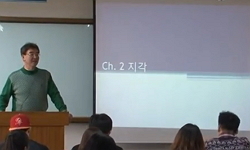The dialogue has been faced with an ordeal in contemporary theatre. Today`s theatre called ``postmodern`` puts emphasis on audio-visual images that appeal to our senses, being freed from the literary text relying on language. Behind this movement is t...
http://chineseinput.net/에서 pinyin(병음)방식으로 중국어를 변환할 수 있습니다.
변환된 중국어를 복사하여 사용하시면 됩니다.
- 中文 을 입력하시려면 zhongwen을 입력하시고 space를누르시면됩니다.
- 北京 을 입력하시려면 beijing을 입력하시고 space를 누르시면 됩니다.

인지과학의 관점에서 본 연극대사 : < 아가멤논 >의 사례를 중심으로 = Theatrical Dialogue From the Viewpoint of Cognitive Science: The Case Study of < Agamemnon >
한글로보기https://www.riss.kr/link?id=A101879210
- 저자
- 발행기관
- 학술지명
- 권호사항
-
발행연도
2011
-
작성언어
-
-
주제어
인지과학 ; 아가멤논 ; 신체 감각적 대사 ; 디케이 ; 생각의 신체화 ; cognitive science ; Agamemnon ; physically sensuous dialogue ; dike ; embodiment of thinking
-
KDC
800
-
등재정보
KCI등재후보
-
자료형태
학술저널
-
수록면
149-184(36쪽)
-
KCI 피인용횟수
2
- DOI식별코드
- 제공처
-
0
상세조회 -
0
다운로드
부가정보
다국어 초록 (Multilingual Abstract)
The dialogue has been faced with an ordeal in contemporary theatre. Today`s theatre called ``postmodern`` puts emphasis on audio-visual images that appeal to our senses, being freed from the literary text relying on language. Behind this movement is the prejudice against dialogue. It is believed that dialogue only expresses the intellectual idea. Because of this bias, the opinion that calls for the nonverbal theatre has emerged as in the case of Artaud. But is it true? My thesis starts with this question. Its basic assumption is that the dialogue can provide the physically sensuous experience. This idea is theoretically supported by the cognitive science. According to the cognitive linguistics, some aspects of word meanings arise from bodily experiences,appealing to the embodied mind. As such, the word not merely communicates the abstract concept but gives the bodily experience of it. Adopting the cognitive science,my thesis attempts to study the theatrical dialogue that causes the physically sensuous experience, leading to the conceptual idea. For this purpose my thesis analyzes the dialogues of Agamemnon as an example. The dialogue of Greek tragedy narrating the past events at length is designed so that we can feel those incidents with a physical sensation to the utmost, creating a kind of virtual action. Consequently it evokes the mental images of those incidents,making us to feel as if seeing them. The embodied emotions acquired this way lead us to think about their meanings through the ensuing cognitive process. To put it simply, the physically sensuous dialogue can cause certain feeling, and the feeling in turn can evoke certain idea. < Agamemnon > may be a good example that illustrates the features of dialogue described so far. Its dialogues not only make us to feel the theme ``dike``, that is, the punishment of justice, with a physical sensation, but also allow us to understand it in a special way. For instance, the speech of the chorus makes us to experience the punishment of Troy with a physical sensation as it narrates that the enraged eagles plunged their claws in a pregnant hare, and thus killed its unborn babies spurting of blood. From this bodily sensation emerges the nature of ``dike``(the punishment of justice). The realization of justice involves another crime. This idea is the result of the bodily sensuous experience that is expanded to the metaphorical meaning. As such, the physically sensuous dialogue can arouse certain idea, not remaining as a mere sense experience. Its result can be described as a ``embodiment of thinking.``
국문 초록 (Abstract)
오늘날 연극에서 말은 수난의 시기를 맞이했다. 소위 ``포스트모던 연극`` 혹은 ``포스트드라마``로 표현되는 현대연극은 이제 말을 중심으로 한 문학적 성격을 벗어나 관객의 감각에 호소하...
오늘날 연극에서 말은 수난의 시기를 맞이했다. 소위 ``포스트모던 연극`` 혹은 ``포스트드라마``로 표현되는 현대연극은 이제 말을 중심으로 한 문학적 성격을 벗어나 관객의 감각에 호소하는 시청각적 이미지를 중시하게 된다. 이런 움직임 뒤에는 대사에 대한 편견이 있다. 즉, 대사는 ``말로 표현할 수 없는`` 삶의 진실을 전달하기에 부적합한 것이다. 그렇기 때문에 아르또처럼 비언어적 연극을 주장하는 입장이 대두되었다. 과연 그럴까? 본 논문은 이와 같은 의문에서 시작되었다. 본 논문의 기본가설은 대사가 신체 감각적인 경험을 일으킬 수 있다는 것이다. 이와 같은 생각은 인지과학에 의해 이론적으로 지지를 받는다. 인지언어학에 따르면, 언어는 구체적인 신체적 경험에서 비롯된 것으로, ``신체화된 마음(embodied mind)``에 호소한다. 이처럼 언어는 단지 추상적 개념을 전달하는 것이 아니라, 그런 상태에 대한 신체적 체험을 유발시킨다. 이에 본 논문은 인지과학의 관점에서 연극대사가 어떻게 신체 감각적인 체험을 불러일으키고, 그 체험이 개념적 사고로 이어지는지를 고찰하고자 한다. 이를 위해 본 논문은 고대그리스 비극인 < 아가멤논 >을 분석의 사례로 삼았다. 과거의 사건들을 아주 길게 서술하는 그리스 비극의 대사는 최대한 그 사건을 신체 감각적으로 느끼게 고안되어 일종의 "가상적 행동(virtual action)"을 창조한다. 그 결과 그리스 비극의 대사는 그것이 묘사하는 사건이나 상황에 관한 ``심상``을 불러일으켜, 마치 우리로 하여금 ``보는`` 것 같은 느낌을 준다. 이렇게 얻어진 ``신체화된 감정``은 후속적인 인지 처리과정을 형성하여 의미를 발생시킨다. 쉽게 말해 신체 감각적인 대사는 특정 느낌을 불러일으키고, 느낌은 특정한 생각을 환기시키는 것이다. < 아가멤논 >은 위와 같은 성격의 대사를 보여주는 사례 중의 하나이다. < 아가멤논 >의 대사는 극의 주제인 ``정의의 응징(dike)``을 신체 감각적으로 느끼게 할 뿐 아니라, 특별한 방식으로 이해하게 하는 것이다. 예를 들어 코러스는 트로이에 대한 응징을 우선 신체 감각적으로 느끼게 한다. 그것은 독수리가 날카로운 발톱으로 어미 토끼를 찢어 죽이고, 이로 말미암아 뱃속의 새끼까지도 피를 토하며 죽는 것이었다. 이와 같은 신체 감각적 느낌에서 ``정의의 응징``이 그 성격을 드러낸다. 즉, 정의 실현은 또 다른 끔찍한 죄를 범하는 것이다. 이와 같은 생각은 강렬한 신체 감각적 경험이 은유적인 의미로 확장된 결과이다. 이처럼 신체 감각적인 대사는 감각적 경험에 머물지 않고 특별한 생각을 환기시킬 수 있다. 그 결과는 ``생각의 신체화``라 할 수 있다. 비언어적인 표현이 각광을 받는 오늘날 우리가 연극의 본질을 언어의 관점에서 되돌아보는 계기가 필요한 것이 바로 이러한 이유에서이다. 그렇게 함으로써 우리는 편파적인 시각을 벗어나, 연극대사에 관한 균형 있는 이해를 도모할 수 있을 것이다.
참고문헌 (Reference)
1 Tonelli, Franco, "잔혹성의 미학: 앙토냉 아르토의 잔혹 연극의 미학적 접근" 동문선 2001
2 Lakoff, G., "삶으로서의 은유" 박이정 2009
3 허버트 A. 사이먼, "문학비평: 인지과학적 접근" (32) : 1442-1951, 1995
4 Lakoff, G., "몸의 철학: 신체화된 마음의 서구 사상에 대한 도전" 박이정 2002
5 McConachie, Bruce, "“Introduction.” Performance and Cognition: Theatre Studies and the Cognitive Turn" Routledge 1-26, 2006
6 Artaud, Antonin, "The Theater and its Double" Grove Press Inc 1979
7 Taplin, Oliver, "The Stagecraft of Aeschylus: The Dramatic Use of Exits and Entrances in Greek Tragedy" Clarendon 1989
8 Aeschylus, "The Oresteia, In Dramatic Verse 1973-1985" Bloodaxe 1985
9 Aeschylus, "The Oresteia" Bantam Book 1977
10 Havelock, Eric A., "The Oral Composition of Greek Drama" 35 : 61-113, 1980
1 Tonelli, Franco, "잔혹성의 미학: 앙토냉 아르토의 잔혹 연극의 미학적 접근" 동문선 2001
2 Lakoff, G., "삶으로서의 은유" 박이정 2009
3 허버트 A. 사이먼, "문학비평: 인지과학적 접근" (32) : 1442-1951, 1995
4 Lakoff, G., "몸의 철학: 신체화된 마음의 서구 사상에 대한 도전" 박이정 2002
5 McConachie, Bruce, "“Introduction.” Performance and Cognition: Theatre Studies and the Cognitive Turn" Routledge 1-26, 2006
6 Artaud, Antonin, "The Theater and its Double" Grove Press Inc 1979
7 Taplin, Oliver, "The Stagecraft of Aeschylus: The Dramatic Use of Exits and Entrances in Greek Tragedy" Clarendon 1989
8 Aeschylus, "The Oresteia, In Dramatic Verse 1973-1985" Bloodaxe 1985
9 Aeschylus, "The Oresteia" Bantam Book 1977
10 Havelock, Eric A., "The Oral Composition of Greek Drama" 35 : 61-113, 1980
11 Peradotto, John J., "Some Patterns of Nature Imagery in The Oresteia" 85 : 378-393, 1964
12 Else, Gerald F., "Ritual and Drama in Aischyleian Tragedy" 2 : 70-87, 1977
13 Else, Gerald F., "Plato and Aristotle on Poetry" University of North Carolina Press 1986
14 Aeschylus, "Oresteia: Agamemnon, The Libation Bearers, The Eumenides" University of Chicago Press 1954
15 Foster, Susan Leigh, "Movement's contagion: the kinesthetid impact of performance, In The Cambridge Companion of Performance Studies" Cambridge UP 46-59, 2008
16 Cook, Amy, "Interplay: The Method and Potential of a Cognitive Scientific Approach to Theatre" 59 : 579-594, 2007
17 Taplin, Oliver, "Greek Tragedy in Action" Routledge 2003
18 Stanford, W.B., "Greek Tragedy and the Emotions: An Introductory Study" Routledge 1983
19 Kitto, H.D.F., "Greek Tragedy" Doubleday & Company, Inc 1954
20 Eisenstein, Sergei, "Film Form: Essays in Film Theory" Harcourt 1949
21 McConachie, Bruce, "Falsifiable Theories for Theatre and Performance Studies" 59 : 553-577, 2007
22 Gibbs, Raymond W., "Embodiment and Cognitive Science Account" Cambridge UP 2006
23 Else, Gerald F., "Aristotle's Poetics" The University of Michigan Press 1970
동일학술지(권/호) 다른 논문
-
- 한국드라마학회
- 김기봉 ( Gi Bong Kim )
- 2011
- KCI등재후보
-
- 한국드라마학회
- 김영학 ( Young Hak Kim )
- 2011
- KCI등재후보
-
- 한국드라마학회
- 전성희 ( Sung Hee Jeon )
- 2011
- KCI등재후보
-
- 한국드라마학회
- 하형주 ( Hyung Ju Ha )
- 2011
- KCI등재후보
분석정보
인용정보 인용지수 설명보기
학술지 이력
| 연월일 | 이력구분 | 이력상세 | 등재구분 |
|---|---|---|---|
| 2028 | 평가예정 | 재인증평가 신청대상 (재인증) | |
| 2022-01-01 | 평가 | 등재학술지 유지 (재인증) |  |
| 2019-01-01 | 평가 | 등재학술지 유지 (계속평가) |  |
| 2017-09-25 | 학술지명변경 | 외국어명 : Drama Research -> The Journal of Drama |  |
| 2016-01-01 | 평가 | 등재학술지 선정 (계속평가) |  |
| 2015-01-01 | 평가 | 등재후보학술지 유지 (계속평가) |  |
| 2014-09-02 | 학회명변경 | 영문명 : 미등록 -> The Korean Drama Society |  |
| 2014-02-12 | 학술지명변경 | 외국어명 : The Drama Association of Korea -> Drama Research |  |
| 2013-01-01 | 평가 | 등재후보학술지 유지 (기타) |  |
| 2012-01-01 | 평가 | 등재후보학술지 유지 (기타) |  |
| 2011-01-01 | 평가 | 등재후보학술지 유지 (등재후보2차) |  |
| 2010-01-01 | 평가 | 등재후보 1차 PASS (등재후보1차) |  |
| 2008-01-01 | 평가 | 등재후보학술지 선정 (신규평가) |  |
학술지 인용정보
| 기준연도 | WOS-KCI 통합IF(2년) | KCIF(2년) | KCIF(3년) |
|---|---|---|---|
| 2016 | 0.48 | 0.48 | 0.48 |
| KCIF(4년) | KCIF(5년) | 중심성지수(3년) | 즉시성지수 |
| 0.48 | 0.47 | 0.877 | 0.14 |




 KCI
KCI KISS
KISS






